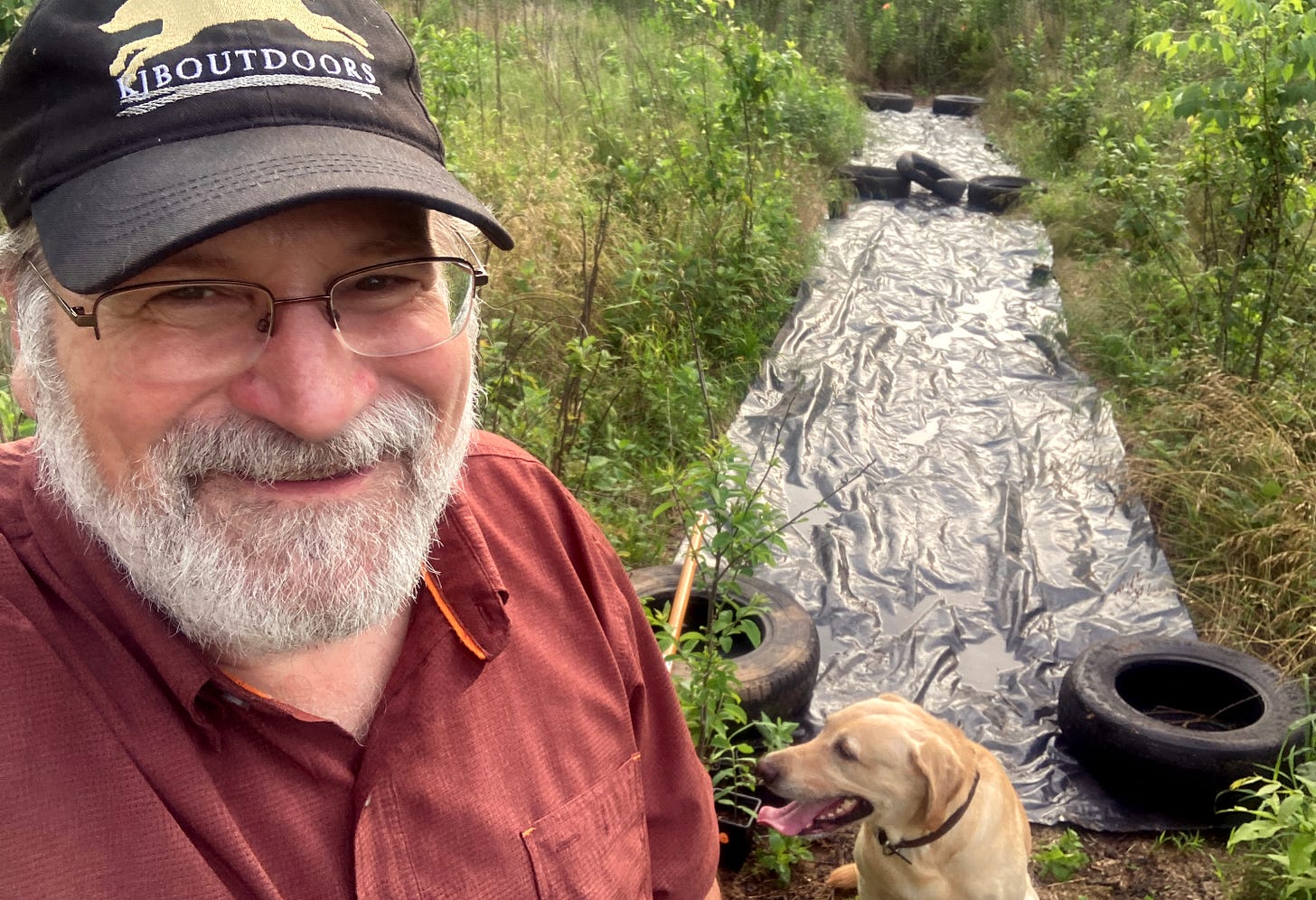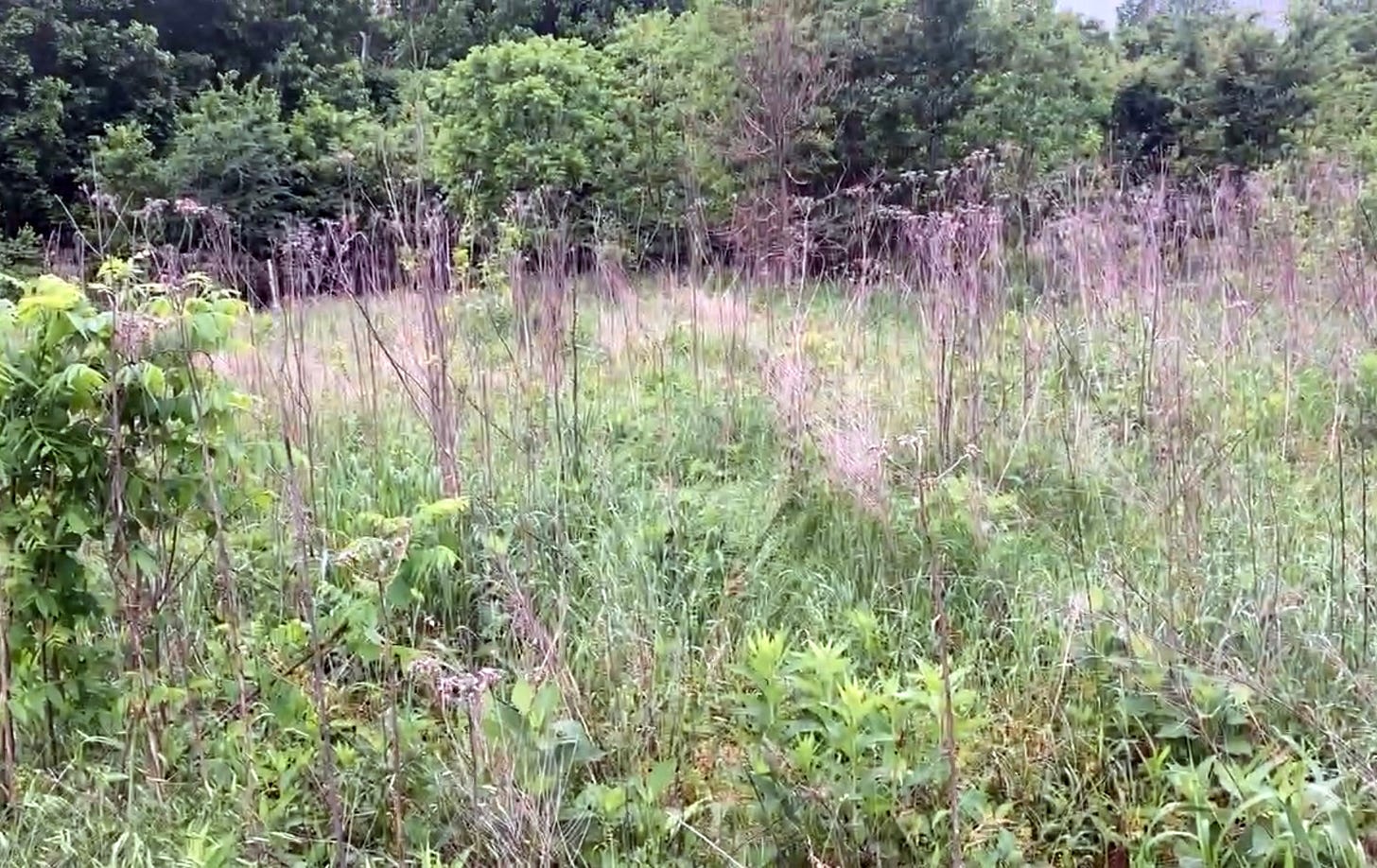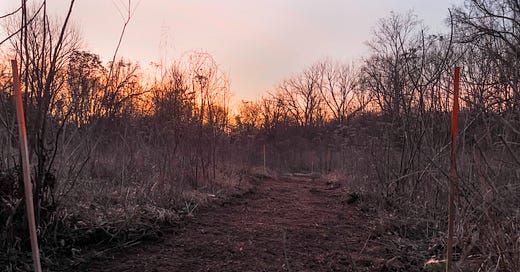Creek Bends: Cleanup on Aisle No. 1
Ups, downs, and a bit of a mess with a wildflower plot solarization attempt

Aisle No. 1 is an idea that grew from my well-intended interpretation of an expert method for wildflower introduction for pollinators.
The part that included me crawling on my hands and knees looking for bits of black plastic on a winter’s afternoon was a result of me being dumb ol’ me.
But I’m not holding one messy time-consuming glitch against this effort.
As I am finding for most things intended to change the habitat at Snake Creek, time will tell if this good-intentioned effort indeed turns out to be, well, good.
The idea was to use solarization to create what I’m now calling Aisle No. 1, thanks to that cleanup effort. It is intended to create a booster plot for wildflowers and milkweeds in the lower meadow. Already I know a thing or two that I would do differently if we decide to do more of these.
Smothering, or solarizing?
What I did to create Aisle No. 1 technically was smothering, I suppose, but it also counts as solarizing to a degree (pun intended).
Soil solarization is what the gardeners call a nonchemical method for controlling pests and weeds by using clear plastic sheeting to capture radiant energy from the sun. Heat up the soil to certain depths day after day and almost everything dies.
The upside is it kills pests and weeds, the downside is it also kills some good stuff in the soil. I’ve seen instructions for solarization that include using black plastic sheeting as well as clear.
Smothering is using any material you want to cut out light and air and kill what is growing. Newspaper, old sheet wood or roofing metal, thick layers of mulch, tarps, and black plastic sheeting are among the various materials used.
In either case, whatever might be growing—in this case lots of Bermuda grass and Sericea—is chopped short, covered, and the material is anchored over the top for weeks, or months until the ground can be more easily prepared for planting. It’s often used to kill out a section of a lawn to start a garden or flower plot.
On Aisle #1, when the weather was cool, plants were smothered, but when the sun hit for a full day on that east-west strip, and when days hit 100+ degrees, I’m sure there was a solarization effect as well.
I dove in without much of a plan. I saw a 10x25-foot roll of 6 Mil black plastic sheeting for $15 at Lowe’s, did quick math on a 5x50 swath, liked the shape of it, and went for it.
And that’s about as much thought as I put into that.
Why, oh why?
The original inspiration for this came from stories I’ve done about the Tribal Alliance for Pollinators and conversations with TAP Co-director Jane Breckenridge of Euchee Butterfly Farm.
TAP has programs I couldn’t hope to mimic, but one basic aspect of their program for tribes that want to restore pastures with milkweed and wildflowers involves mowing small areas short and then using an auger to plant plugs of well-established native milkweeds and wildflowers. The plugs have an advantage over surrounding vegetation and off they go—essentially.
But at Snake Creek we have Sericea lespedeza and, as the saying goes, “Sericea loves a mower.”
Breckenridge said she didn’t know of anyone who had tried specifically to smother (or solarize) a Sericea inundated area but, in any case, it might be an interesting experiment.
“Why not?” I thought.
On May 21 I used a weed-eater and my lawnmower to clear an east-west strip, a little over 50 feet long and about 6 feet wide, covered it with the sheeting, staked it down, and put some junk tires that were lying around on top to hold it down.
Easy peasy.

The downside
My mistake was thinking that 6 Mil black plastic sheeting would hold together for seven months.
I’d check in on it every so often, after a big wind or a storm, but it held together for the most part. A stake came loose here and there, but generally, it was fine.
In November, I noticed the plastic was starting to split up the center in some places but it just didn’t register as a problem.
What I really noticed was the incredible piles of seeds on top of the plastic, thousands, scattered from the weeds all along the runway.
But then came winter storms, extreme cold, and high winds.
I was at home when I saw that high-wind warning and I thought of that plastic out at the creek.
That was a forehead slapper. I pictured that semi-brittle plastic ripping and whipping around in a 40 mph north wind, and that’s exactly what happened.
It held together and the edges remained staked, for the most part, but pieces of it—probably from being beaten against the nearby standing vegetation—disintegrated into the equivalent of black leaves swirling in the wind.
What a mess.
The cleanup turned into an Easter egg hunt. Ultimately, I was left with thumbnail size and larger pieces of plastic scattered across Aisle #1, so I used a leaf rake to clean it all up. In the process, I lost a nice layer of detritus, which amounted to composted vegetation that had formed under the plastic. But, to the best of my ability, all the plastic now is gone.

The (almost) end result
Sometime around the opening day of quail season, I mentioned my little experiment, in passing, to Tell Judkins, Upland Game Biologist with the Oklahoma Department of Wildlife Conservation.
Ultimately he, like many other land managers, suggested that the meadow will get to what it needs to be—eventually—all on its own.
“Just keep lighting matches,” he said—among other things.
One interesting idea he offered was that, as long as I had already smothered that plot, what might be more interesting than planting wildflowers and milkweeds would be to just let the plot come back on its own and see what grows.
Interesting idea.
In the end, I used a bow rake on half the plot to rough up the surface with the remaining detritus and planted two 1-ounce packets of Johnston Seed Company Okies for Monarchs (eastern Oklahoma) seed mix. I left the other half of the aisle alone, with the exception of raking up the plastic.
I still like the idea of the TAP approach of planting target species to give the place a boost.
If I could change anything so far it would be the mess, of course. I could have pulled the plastic and planted wildflower seeds in November. I also would have chosen my spot earlier and better documented exactly what was growing there for later comparison.
For now, though, this isn’t bad. Time will tell if it did any good.




Super! I was thinking of finding an old tarp or something as I picked up that dumb plastic...
I have a very heavy duty tarp I would donate if you'd like to try. If it works out you can keep it.